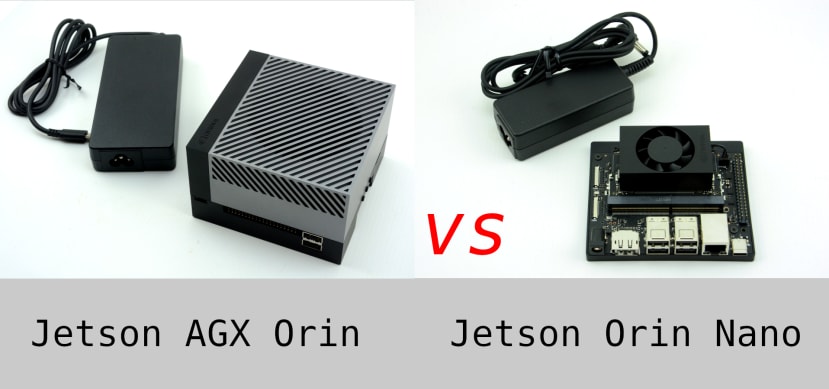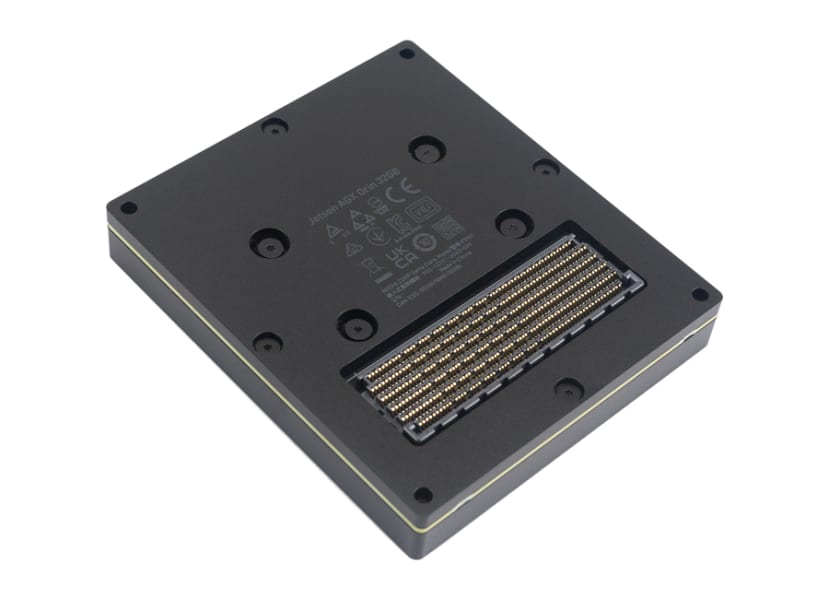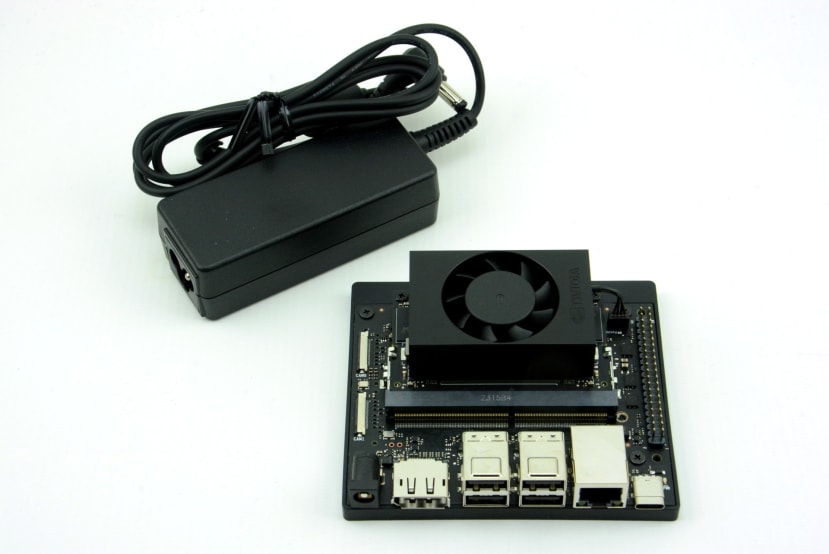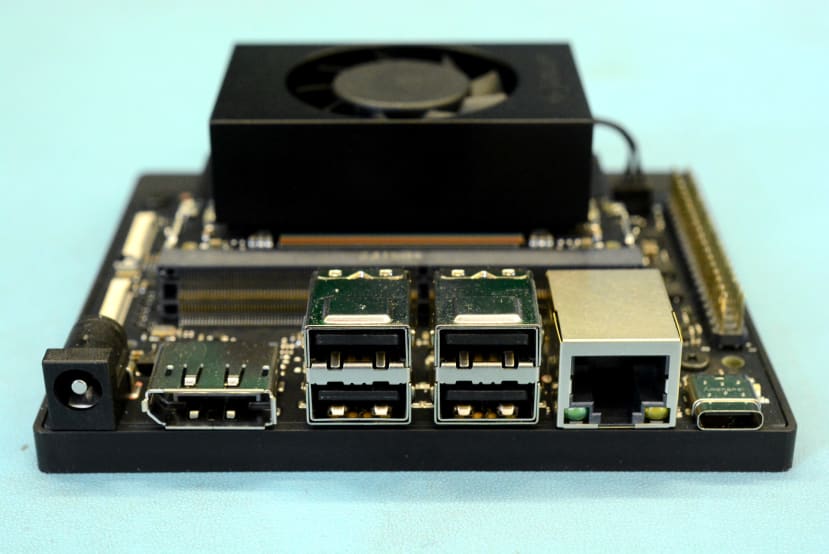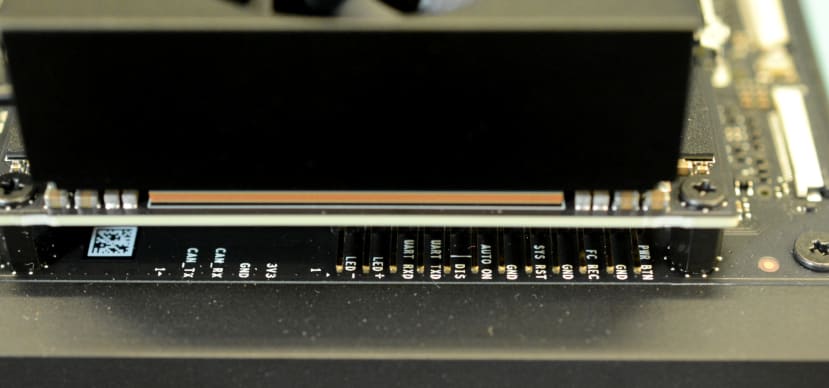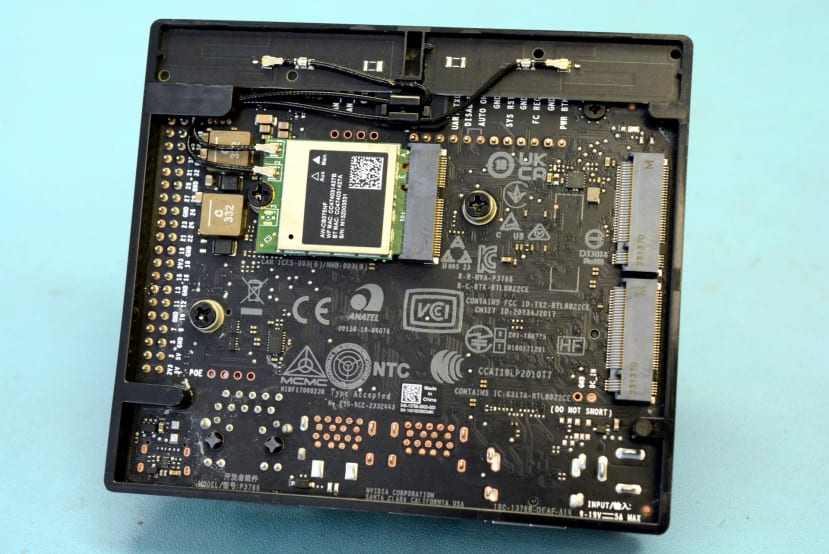Jetson AGX Orin and Orin Nano Comparison Part 1: Features and Specifications
Follow articleHow do you feel about this article? Help us to provide better content for you.
Thank you! Your feedback has been received.
There was a problem submitting your feedback, please try again later.
What do you think of this article?
A side-by-side comparison of the flagship and entry-level developer kits in NVIDIA’s latest and greatest family of embedded platforms for edge AI.
In previous articles we’ve taken a look at the original Jetson Nano platform (basic hands-on and AI follow trolley project), and the powerhouse that is the Jetson AGX Orin (first look and basic setup).
In this two-part series, we will now contrast and compare the developer kit for the top-end Jetson AGX Orin, with the smaller and much lower-cost Jetson Orin Nano. We will start in Part 1 by exploring the features and specifications of each, following which in Part 2 we will execute some example workloads and compare the relative performance of the two platforms.
As we will come to see, the Jetson Orin Nano, although less powerful than Jetson AGX Orin, represents a tremendous increase in performance over the original Jetson Nano which launched back in 2019. Meanwhile selecting which member of the Jetson Orin family to use in a project is, as with many things, a question of the best tool for the task at hand and not simply a matter of budget.
Comparisons
While noting that there are many considerations other than just cost, this is an obvious one to start with and at the time of writing the top end Jetson AGX Orin 64GB Developer Kit (253-9662) comes in at just under £2,200 with VAT, while the Jetson Orin Nano Developer Kit (264-7384) is a little under £550. We’ll come on to developer kit differences, but these are mostly just “breakout boards” for the Jetson System-on-Modules (SoMs) and it’s here we get to see the real difference in what is provided.
SoM Specifications
It’s important to note that there are multiple variants of both the Jetson AGX Orin and Jetson Orin Nano SoMs, with varying levels of processing power and RAM, for example. In the case of AGX Orin there are also two Developer Kit options, identified as having 64GB and 32GB RAM, although there are other differences and for details see, A First Look at the NVIDIA Jetson AGX Orin. With Orin Nano there is just one Developer Kit, but two SoM options for production designs.
The above table is from the Jetson Orin Modules and Developer Kits section of the NVIDIA website, which also includes details for Orin NX, but these have been omitted here to help make the table more legible and also because we are focusing on AGX Orin and Orin Nano.
From the specifications table, we can see that AI performance ranges from 20 TOPS for Orin Nano 4GB, through to 275 TOPS for AGX Orin 64GB. Although the Jetson Orin Nano Developer Kit is equipped with an 8GB RAM SoM and this is specified at 40 TOPS. This is courtesy of a GPU with Ampere architecture + Tensor cores, scaling from 512+16 respectively with Orin Nano 4GB, all the way up to 2048+64 with AGX Orin 64GB. With the GPU clock speed pretty much doubling also.
Similarly, we see that the Orin Nano series feature a 6-core Cortex A-78AE CPU, which increases to 8-core with AGX Orin 32GB, and 12-core with AGX Orin Industrial and 64GB variants. AGX Orin SoMs additionally benefit from 2x deep learning accelerators and a vision accelerator.
All Orin SoMs support external NVMe storage and the developer kits make provision for interfacing this. Additionally, the Orin Nano developer kit has a Micro SD card slot, while the AGX Orin benefits from 64GB of soldered-down eMMC storage.
There are significant differences in the video encode and decode capabilities, plus AGX Orin SoMs provide 16x lanes of MIPI CSI-2 for connecting cameras, as opposed to 8x lanes with Orin Nano. Other standout differences include that AGX Orin modules provide more PCIe connectivity.
Another key difference is that 32GB and 64GB AGX Orin variants feature 10G and 1G Ethernet ports, whereas AGX Orin Industrial and all Orin Nano modules just have a single 1G interface.
Jetson AGX Orin and Orin Nano modules
The AGX Orin SoM is 100 x 87mm, employs a 699-pin Molex Mezz connector and is supplied with an integrated thermal transfer plate (TTP), which adds to the overall thickness. The Orin Nano meanwhile is closer to half the size at 69.6 x 45mm, utilises a smaller 260-pin SO-DIMM connector, and is not packaged with a TTP. In terms of power consumption the AGX Orin SoMs peak at 75W, while the more powerful of the Orin Nano SoMs tops out at 15W.
NVIDIA Jetson AGX Orin with Thermal Transfer Plate
It should come as no surprise that the most powerful SoMs in the Jetson Orin family are quite a bit larger and consume more power than the entry-level SoMs. However, we are talking about an awful lot of compute performance being squeezed into what is still a reasonably small footprint of 100 x 87mm, with a peak power consumption of just 75W for the very top of the range.
While we’re not considering the mid-range Orin NX in any detail as part of this comparison, it should be noted that this provides a convenient upgrade path for designs which start out with Orin Nano, given it employs the same form factor and connector, with a slightly increased peak power consumption of only 25W, for more than double the AI performance, plus numerous other upgrades.
However, moving from either Jetson Orin Nano or Jetson Orin NX, to Jetson AGX Orin, would require a design to be updated, at least for the different connector used, if not for the increased power budget also. Hence careful consideration should be given to potential future requirements.
So as we’ve seen, there is quite a range of differences not just in AI performance, but in terms of CPU, memory and connectivity also. Hence there may be cases where a module with a lower AI performance may otherwise suffice, but more CPU or RAM is required for the overall application, or perhaps increased connectivity for peripherals.
Developer Kits
As with the AGX Orin, the Orin Nano Developer Kit is well packaged, and it comes with everything needed to get up and running minus a Micro SD card.
Similarly, the Orin Nano kit includes a reference carrier board fitted with a SoM and cooling, plus a desktop DC power supply. As one might expect, the Nano carrier board plus SoM assembly is smaller — it has a similar footprint but is about half the height — and with a smaller PSU. The packaging is also much more basic, with the carrier board on a simple plastic sled, instead of being fitted into a rather fancy aluminium enclosure with a magnetic cover over a full-size PCIe slot.
Both AGX Orin and Orin Nano developer kits feature 4x USB ports, albeit with the Orin dev kit there are two at one side and two on the opposite side, whereas the Nano carrier board has them all on one side. AGX Orin supports up to 10G Ethernet, while Nano supports only up to 1G.
As with the larger AGX Orin carrier board, there is a GPIO header to one side.
Then on the opposite side a pair of MIPI CSI headers for connecting embedded cameras.
Underneath the Jetson SoM on the side opposite the main ports, there is a “Button Header” which features pins for a status LED and buttons, plus UART. To the side of which there is an optional CAN bus header which may be fitted.
Finally, if we look on the underside of the Orin Nano dev kit we will find that there is an M.2 Slot (Key-E, Type 2230) which is already populated with a WiFi/Bluetooth adapters, that is cabled to a pair of PCB antennas. There are also M.2 Key-M 2280 (PCIe 3.0 x4) and 2230 (PCIe 3.0 x2) slots, with the former being well-suited to use with NVMe storage.
Final words
Here we have seen how there is quite a wide range of AI/CUDA processing performance available across the Jetson Orin family, from the entry-level Orin Nano module through to the top-end AGX Orin SoM. Meanwhile, the differences between Orin Nano and AGX Orin platforms are more distinct, as the latter integrates a more powerful CPU complex, greater video capabilities and higher performance Ethernet, along with increased MIPI CSI and PCIe connectivity. Although this does obviously come at increased size, weight — not so much admittedly — power and cost.
As such consideration should be given to overall system requirements when deciding whether to go with Jetson Orin Nano or Jetson AGX Orin, and not just AI performance, for example.
In the 2nd and concluding part of this series, we will run some typical AI workloads on AGX Orin and Orin Nano development kits to provide a real-world comparison.


